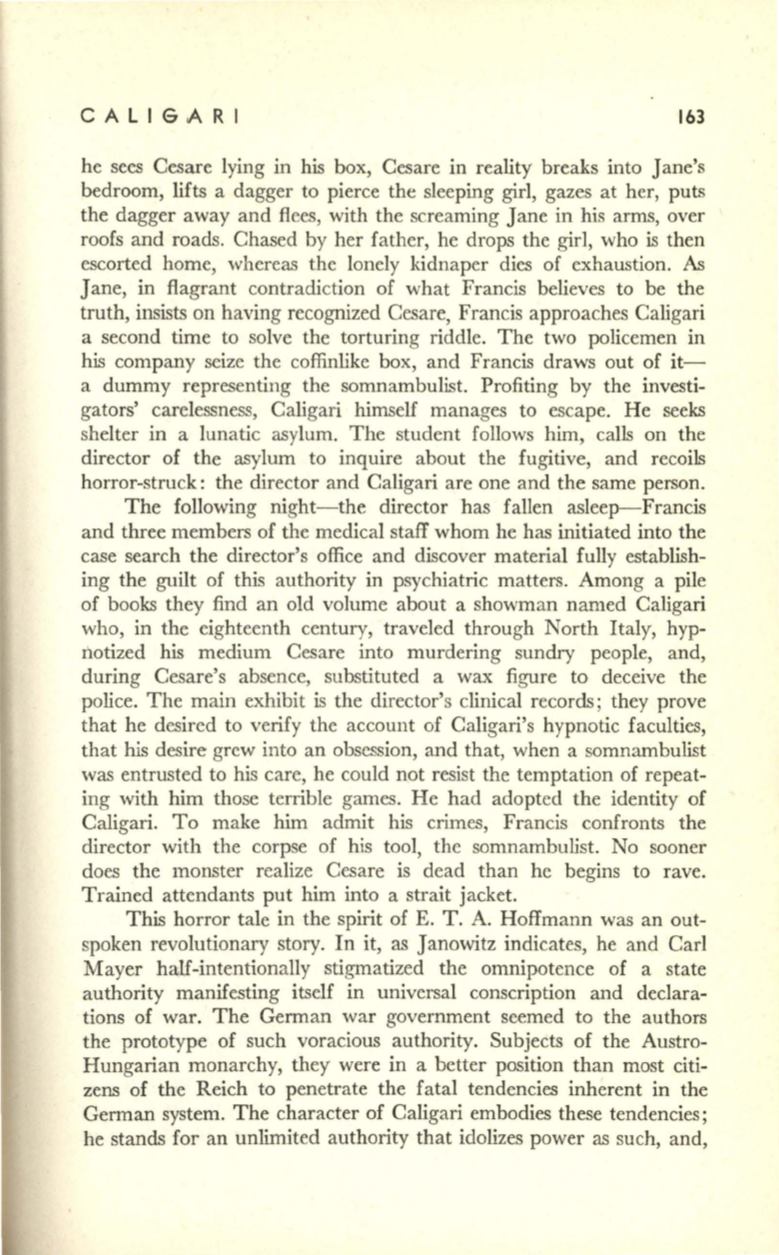
CALIGARI
163
he sees Cesare lying in his box, Cesare in reality breaks into Jane's
bedroom, lifts a dagger to pierce the sleeping girl, gazes at her, puts
the dagger away and flees, with the screaming Jane in his arms, over
roofs and roads. Chased by her father, he drops the girl, who is then
escorted home, whereas the lonely kidnaper dies of exhaustion.
AB
Jane, in flagrant contradiction of what Francis believes to be the
truth, insists on having recognized Cesare, Francis approaches Caligari
a second time to solve the torturing riddle. The two policemen in
his company seize the coffinlike box, and Francis draws out of it–
a dummy representing the somnambulist. Profiting by the investi–
gators' carelessness, Caligari himself manages to escape. He seeks
shelter in a lunatic asylum. The student follows him, calls on the
director of the asylum to inquire about the fugitive, and recoils
horror-struck: the director and Caligari are one and the same person.
The following night-the director has fallen asleep-Francis
and three members of the medical staff whom he has initiated into the
case search the director's office and discover material fully establish–
ing the guilt of this authority in psychiatric matters. Among a pile
of books they find an old volume about a showman named Caligari
who, in the eighteenth century, traveled through North Italy, hyp–
notized his medium Cesare into murdering sundry people, and,
during Cesare's absence, substituted a wax figure to deceive the
police. The main exhibit is the director's clinical records; they prove
that he desired to verify the account of Caligari's hypnotic faculties,
that his desire grew into an obsession, and that, when a somnambulist
was entrusted to his care, he could not resist the temptation of repeat–
ing with him those terrible games. He had adopted the identity of
Caligari. To make him admit his crimes, Francis confronts the
director with the corpse of his tool, the somnambulist. No sooner
does the monster realize Cesare is dead than he begins to rave.
Trained attendants put him into a strait jacket.
This horror tale in the spirit of E. T.
A.
Hoffmann was an out–
spoken revolutionary story. In it, as Janowitz indicates, he and Carl
Mayer half-intentionally stigmatized the omnipotence of a state
authority manifesting itself in universal conscription and declara–
tions of war. The German war government seemed to the authors
the prototype of such voracious authority. Subjects of the Austro–
Hungarian monarchy, they were in a better position than most citi–
zens of the Reich to penetrate the fatal tendencies inherent in the
German system. The character of Caligari embodies these tendencies;
he stands for an unlimited authority that idolizes power as such, and,


